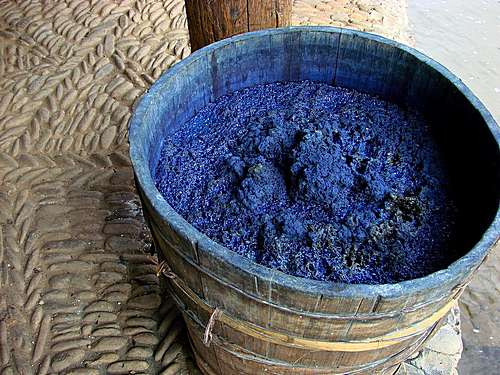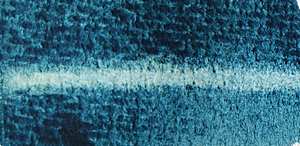Mayan blue

People have long wondered how the Mayan people, thousands of years ago, could produce a blue color so resistant to light, moisture and other degrading factors that after a thousand years, or more, the objects are still beautifully blue.
In order to discover the mystery of Mayan blue, extensive research and scientific investigations have been carried out.
After decades of research, so much has been discovered that today you can buy commercially produced Mayan blue color pigment and paint.

How Mayan blue is produced
Indigo is a plant from which indigo blue can be made, the color is extracted from the leaves of the plant. Indigo is a common color in watercolour, but nowadays is never natural but a mixture of blue and black and maybe even red. The problem with natural indigo is that the color fades quite quickly from sunlight.
Palygorskite is a clay mineral common in North America, it is less common in Mexico but occurs. By crushing and grinding palygorskite into a fine powder, the Maya chemists were able to produce an important ingredient in the manufacture of this paint.
The indigo pigment is then mixed with the palygorskite powder in carefully controlled proportions, knowledge that is now lost. I suppose they have simply experimented their way to proportions.

Toma1974, CC BY-SA 4.0 https://creativecommons.org/licenses/by-sa/4.0, via Wikimedia Commons

gitane, CC BY 3.0 https://creativecommons.org/licenses/by/3.0, via Wikimedia Commons
The mixture of indigo pigment and palygorskite was then placed in a furnace and heated to a high temperature. The temperature is assumed to be around 300-500°C.
When heated, a chemical reaction occurred between the indigo dye and the palygorskite. This reaction resulted in the formation of stable blue crystals, which made up the unique Maya Blue pigment.
This was a simplified description of what is today considered to be the method the Mayans used. Continued investigation and experimentation continues.
Watercolor paint
As a watercolor paint it is not that common, only two major manufacturers have the paint, Rublev (Natural Pigments) and Daniel Smith. There are also quite a few small manufacturers that provide it.

The color is very lightfast, does not stain, quite transparent and granulates. The color tone can be described as dirty blue turquoise.
To achieve a neutral color mixture, you must use a reddish brown color such as Indian Red or Quinacridone Burnt Scarlet. Most more orange brown colors, e.g. burnt sienna or umber, become strongly greenish together with Mayan blue.
Mayan blue from Daniel Smith has an attractive blue-green unclear color tone that gives a slightly greenish color scale in a painting when mixed with other colors. The same manufacturer also has a color they call Mayan Dark Blue which is blacker and warmer. The color from Natural pigments is slightly less green and more unclear.
The first thing you notice when Mayan Blue is squeezed out of a tube is that the color feels “gluey”. An experience that is enhanced when you add a little water and mix it with other colors. It is not a color that lends itself to overpainting and post processing, it works best when painted quickly and without impact afterwards.
Another surprising feature of the paint is the drying time. Mayan blue dries very slowly. All types of overpainting should be avoided before the paint is completely dry. The result of premature overpainting can be devastating to the painting.
Mayan blue is, in my opinion, a very nice watercolor paint that is blackish blue turquoise. It works great for, for example, a slightly toned-down sky like in the painting below. However, the color is quite unruly and is hardly a color I would recommend to beginners.






Information
Color index name: PB82
Lightfastness: Extremely light resistant
Transparency: Transparent
Staining: Not at all
Granulates: Yes












